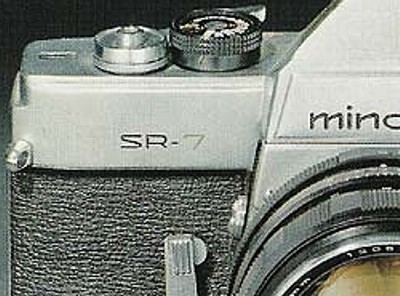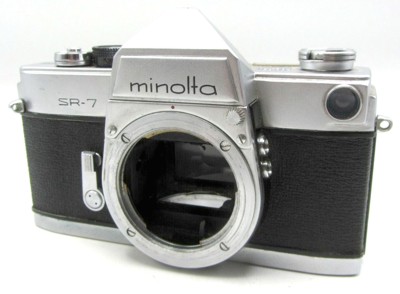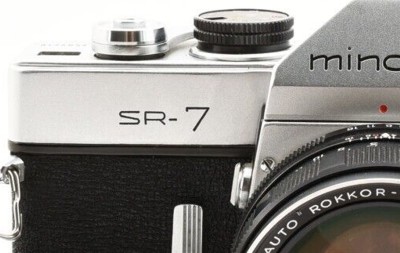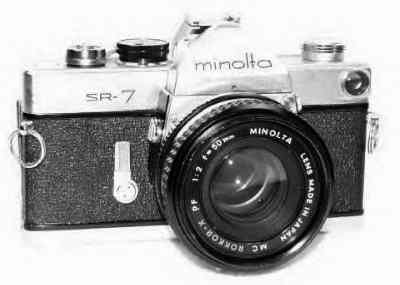

SR-7
(1962) By 1961, the writing was on the wall. The Japanese photographic industry had to produce a 35mm SLR with interchangeable lenses AND a built-in meter -- and FAST! Canon did it with the Canonflex RM in 1961, but it had an unresponsive selenium meter. In the same year, Minolta produced a similar SLR with a built-in selenium meter, the Minolta ER, but it lacked interchangeable lenses. But the following year, in 1962, Minolta was able to step-up to the plate and market the amazing SR-7, the first Minolta SLR with interchangeable lenses AND and built-in meter. It was a CDS meter, to boot! In fact, it was the first Japanese SLR to accomplish this feat. Minolta was once again at the leading edge of the Japanese 35mm SLR market. In this model, the large, external, clip-on meter of the SR-3 is moved inside the camera body, but the size of the camera body did not increase -- a rather remarkable achievement. Admittedly, the meter was not TTL, and the meter readout was on the top of the camera, but it was still quite an accomplishment for the time. To top it off, the meter was coupled to the shutter speed, so exposure adjustment was very easy. First, dial the film speed into the meter. Then select a shutter speed that's appropriate for the subject and setting. Next, point the camera at the subject and the meter's needle points to the correct f-stop. Exposure was never so quick. The SR-7 has a "dual-range" exposure meter. Normally, a metal plate with a tiny hole sits in front of the meter's CDS sensor, which is for high range (i.e. high luminance) readings. By pressing a button on the back of the camera, the plate exposes the full sensor (for poorly lit situations), which also brings up another scale on the meter's f-stop display. So the camera could operate in bright conditions and in very low light, something cameras with built-in selenium meters simply couldn't do. In addition, this camera included a mirror lockup for use with the new super-wide Minolta Rokkor 21mm lens. One of the drawbacks to the use of SLR cameras -- at the time -- was the lack of any wide, wide-angle lenses. A 28mm lens was as wide as you could expect to find on an SLR. The problem was that a super-wide lens had to be so deeply recessed into the camera body that the SLR's mirror would be blocked from moving out of the light path by the back of the lens. (This was not a problem with other types of cameras, such as rangefinders because they lack the reflex mirror.) Minolta came up with an innovative solution and built a mirror lock-up into the SR-7. By moving the mirror up and out of the way, deeply recessed lenses could be used. Since the mirror was now in the "up" position, the viewfinder was blacked-out and the subject could not be viewed, but Minolta solved this problem by including separate viewfinders with their super-wide 21mm lenses. The viewfinder slips into the flash shoe and shows you, approximately, what will be recorded on the film. But the lock-up feature was not needed for long. The development of retro-focus (inverted telephoto) lenses negated the need for the mirror lock-up and the 21mm lens was the only lens that Minolta made that required the use of the mirror lockup. Minolta would go on to make lenses as short as 7.5mm that do not have a recessed design and do not need the mirror lock-up. But the lockup device continued to appear on many Minolta SLR camera bodies and is useful for other reasons, such as reducing vibrations in macro- and tele-photography.
But back to the SR-7. Much like the Minolta SR-1, the SR-7 evolved over time. Even though these changes to the SR-7 are covered in the user manuals, Minolta only gave the final model a different designation (see below), but it was only written on the owner's manual -- not the camera body. So, just as with the Minolta SR-1, we have created our own designations -- to try to avoid confusion. We have grouped these into four versions of the SR-7 although the bodies of the camera are not marked in any way:
SR-7 (model a) -- (1962)

The features of this camera were top-of-the-line -- for the era. The meter-coupler block of the earlier SR
cameras was removed which gives the camera a cleaner look, and a mirror lock-up was added for use with the new,
deep-seated 21mm lens. This was Minolta's first camera with a mirror lock-up device, but it would appear on many
later cameras, as well. This is not only useful with the recessed 21mm lens, but it is beneficial in macro and
telephoto situations because it reduces vibration. Another change with the SR-7, this one rather significant, was
an increase in the size of the SLR mirror. On previous models, Minolta used a mirror that was supported by a simple,
straight hinge. This was an adequate configuration, but it resulted in some image cut-off when viewing the subject
under high magnification, such as with long telephoto or macro lenses. In the SR-7 (model a), this simple configuration
was replaced with a more complicated pair of articulated levers which allow the use of a larger mirror. Minolta
referred to this as an "over-sized" mirror, and it eliminated any image cut-off. The other features of
the SR-7 were the same as those of the SR-3. You'll know if you have this model because the
engraved "7" on the body is GREEN, while the "SR-" is black. The model a is engraved "CHIYODA
KOGAKU" with the serial number on the back. Since the meter lacks a battery on-off switch, owners would use
the camera case (or some black electrical tape in a flap-like arrangement) to cover the CDS cell when the camera
was not in use, so the battery would last longer. The SR-7 (model a) is normally seen in chrome, but a black version
was available.
SR-7 (model b) -- (late 1962)

On this model, the engraved "SR-" and "7" are both black. There may or may not be other internal
or external changes, but the black "7" is what to look at -- see also model c, below.
SR-7 (model c) -- (1963)

The original Minolta SR-7 had a couple of shortcomings. The model c was an attempt to correct these. First,
the earlier model lacks a battery on-off switch. The meter was always "ON". The model c corrected
this shortcoming and added a switch -- on the bottom of the caamera -- with ON & OFF. It lacked the BC setting
of the later SRT cameras, but the batteries lasted a long time if regularly turned off. In addition, the advance
lever was also redesigned on the model b to eliminate the hole that the very sharp advance lever of the earlier
SR-7 would drive in your thumb! It was still not plastic-covered at this point, but was more rounded. It
was a big improvement. Last, but not least, on the original model, it was necessary to waste an exposure
in order to lock up the mirror. The model c allowed the device to be used without firing a frame. Also on
this model, the engraved "7" is larger than the "SR-" -- unlike the earlier models (see above).

This model is engraved "MINOLTA CAMERA CO., LTD" with the serial number on the top. The SR-7 (model c)
is normally seen in chrome, but a black version was available.
SR-7 (model V) -- (1965)

The final version of the SR-7, the model V, switched to a type B body (see previous models), which was slightly smaller and had a sleeker appearance with fewer and smaller ridges around the top edges. In reality, the changes to the size of the body were minimal, and you probably won't notice the differences right away. The camera is just a couple of millimeters thinner and only a couple of millimeters shorter, and the width is the same -- but it's slightly heavier!S The pentaprism is somewhat smaller and the Minolta logo is now placed on the angled part of the prism (on the earlier models it was on the flat front part). In addition, the corners of the body are more square -- like the later SRT bodies. But there were several other changes that were more than cosmetic. Most importantly, the model V has a new rectangular viewfinder. The previous models had a circular viewfinder, so a new accessory shoe was needed, and all other eyepiece attachments had to be reconfigured. These are designated with a "V", such as the Anglefinder V and the Viewfinder Magnifier V. Another change was that the low range button on the back of the camera has been moved to the front of the camera -- in the same place as the lens release button on the later X-series cameras. This made it much easier to use. You no longer needed to move your left hand away from the lens to adjust the meter -- just press it with your thumb. The FP and X flash contacts were lowered slightly on the body, as a result, but otherwise are exactly the same. Also changed was the shutter speed dial. It's now larger and easier to rotate. Perhaps the most important functional change was that the fastest shutter/flash synch speed was increased from 1/45 to 1/60. Instead of a red "X" in-between 1/30 and 1/60, the "60" now appears in red. The self-timer is the same overall size, but has a larger slotted surface and a new push-button underneath. The previous models had a tab that was pressed sideways. In addition, the exposure counter has a larger window and is easier to read. The film rewind button is slightly more recessed -- making it more difficult to press accidentally -- and making it easier to remove the bottom plate of the camera. Also, the lens mount is changed slightly. It now has an angle cut so lenses are easier to attach to the camera. Before, the lens had to be lined up perfectly with the camera. Now, the lenses slip on effortlessly. The camera also sported a new, more comfortable, plastic tip on the film advance lever. In addition, the battery ON/OFF switch was modified to include a battery check setting, marked "BC". Lastly, the film take-up spool is larger and has an internal slot for capturing the film, instead of an external slit. In sum, the changes in the model V were not substantial, but they were numerous. ‘Model V’ is not inscribed on the body, but it does appear on the instruction manual. The SR-7 (model V) is normally seen in chrome, but a black version was available.
For a comparative look at the major features of the various SR-7 models, check out MINMAN's SLR table -- the world's most complete!
| Camera |
SR-7 |
SR-7 |
SR-7 |
SR-7 |
| Model | a | b | c | V |
| Years made | 1962 | 1962-1963 | 1963-1965 | 1965-1966 |
| Type | Mechanical 35mm SLR | Mechanical 35mm SLR | Mechanical 35mm SLR | Mechanical 35mm SLR |
| Shutter | Fully mechanical, horizontal, cloth focal plane shutter | Fully mechanical, horizontal, cloth focal plane shutter | Fully mechanical, horizontal, cloth focal plane shutter | Fully mechanical, horizontal, cloth focal plane shutter |
| Metering | Built-in CDS meter coupled to shutter speed and film speed | Built-in CDS meter coupled to shutter speed and film speed | Built-in CDS meter coupled to shutter speed and film speed | Built-in CDS meter coupled to shutter speed and film speed |
| Meter sensitivity | EV1 to 17 | EV1 to 17 | EV1 to 17 | EV1 to 17 |
| Exposure modes | Unmetered manual Metered manual |
Unmetered manual Metered manual |
Unmetered manual Metered manual |
Unmetered manual Metered manual |
| Automatic exposure adjustment |
-- | -- | -- | -- |
| Viewfinder | Fixed eye-level pentaprism | Fixed eye-level pentaprism | Fixed eye-level pentaprism | Fixed eye-level pentaprism |
| Focusing screen | Fresnel-field screen with a micro-prism center | Fresnel-field screen with a micro-prism center | Fresnel-field screen with a micro-prism center | Fresnel-field screen with a micro-prism center |
| Lens mount | Minolta SLR bayonet | Minolta SLR bayonet | Minolta SLR bayonet | Minolta SLR bayonet |
| Lenses | Optimum: later Auto Rokkor Usable: early Auto Rokkor, Rokkor, MC Rokkor, MC Rokkor-X, MC Celtic, MD Rokkor, MD Celtic, MD Minolta |
Optimum: later Auto Rokkor Usable: early Auto Rokkor, Rokkor, MC Rokkor, MC Rokkor-X, MC Celtic, MD Rokkor, MD Celtic, MD Minolta |
Optimum: later Auto Rokkor Usable: early Auto Rokkor, Rokkor, MC Rokkor, MC Rokkor-X, MC Celtic, MD Rokkor, MD Celtic, MD Minolta |
Optimum: later Auto Rokkor Usable: early Auto Rokkor, Rokkor, MC Rokkor, MC Rokkor-X, MC Celtic, MD Rokkor, MD Celtic, MD Minolta |
| Mirror | Instant return, over-sized mirror | Instant return, over-sized mirror | Instant return, over-sized mirror | Instant return, over-sized mirror |
| Film speeds | -- | -- | -- | -- |
| Shutter speeds | Mechanical: 1 - 1,000; B Manual: 1 - 1,000; B |
Mechanical: 1 - 1,000; B Manual: 1 - 1,000; B |
Mechanical: 1 - 1,000; B Manual: 1 - 1,000; B |
Mechanical: 1 - 1,000; B Manual: 1 - 1,000; B |
| Flash synch | X: B; 1 - 1/60 FP: B; 1 - 1/15 M: B; 1 - 1/15 MF: B; 1 - 1/15 |
X: B; 1 - 1/60 FP: B; 1 - 1/15 M: B; 1 - 1/15 MF: B; 1 - 1/15 |
X: B; 1 - 1/60 FP: B; 1 - 1/15 M: B; 1 - 1/15 MF: B; 1 - 1/15 |
X: B; 1 - 1/60 FP: B; 1 - 1/15 M: B; 1 - 1/15 MF: B; 1 - 1/15 |
| Flash connection | Clip-on, cold shoe X and FP PC contacts |
Clip-on, cold shoe X and FP PC contacts |
Clip-on, cold shoe X and FP PC contacts |
Clip-on, cold shoe X and FP PC contacts |
| Film counter | Automatically resetting type counting upward | Automatically resetting type counting upward | Automatically resetting type counting upward | Automatically resetting type counting upward |
| Battery | one 625 mercury battery | one 625 mercury battery | one 625 mercury battery | one 625 mercury battery |
| DOF/Stop-down button | No | No | No | No |
| Film Back | Non-interchangeable | Non-interchangeable | Non-interchangeable | Non-interchangeable |
| Multiple exposures | No | No | No | No |
| Film advance | Lever type | Lever type | Lever type | Lever type |
| Self-timer | Mechanical, overrideable, non-cancellable, adjustable from 4 to 10 seconds | Mechanical, overrideable, non-cancellable, adjustable from 4 to 10 seconds | Mechanical, overrideable, non-cancellable, adjustable from 4 to 10 seconds | Mechanical, overrideable, non-cancellable, adjustable from 4 to 10 seconds |
| Film reminder | ASA speed selector Rotating ASA/DIN converter |
ASA speed selector Rotating ASA/DIN converter |
ASA speed selector Rotating ASA/DIN converter |
ASA speed selector Rotating ASA/DIN converter |
| Other | Cable release connection, tripod socket | Cable release connection, tripod socket | Cable release connection, tripod socket | Cable release connection, tripod socket |
| Body size | 2 x 3 1/2 x 5 3/4 inches | 2 x 3 1/2 x 5 3/4 inches | 2 x 3 1/2 x 5 3/4 inches | 2 x 3 1/2 x 5 3/4 inches |
| Body weight | One pound two ounces | One pound two ounces | One pound two ounces | One pound six ounces |
The Minolta SR-7 raised the bar in the photographic industry. It was the first Japanese SLR to be fitted with an internal, coupled CDS meter. Just dial in the ISO and the shutter speed, and the camera tells you what f-stop to use. Talk about convenience! Now everyone wanted an SLR with an internal meter. The only problem was that the meter on the SR-7 was not a TTL meter, and by 1965, other manufacturers had already put TTL meters in their cameras -- like the Asahi Spotmatic of 1964. Minolta had to scramble, once again, to keep up with the demand -- demand that their own innovation had generated. Minolta was working on the innovative SR777 -- which had a TTL meter -- but it had many competitors and severe limitations. Wisely, Minolta chose a different route and made photographic history once again. In the following year, 1966, Minolta would produce the incredible SRT101. The world of photograhy would be changed forever!
We didin't want to do this, but since other websites have been stealing our stuff, we have no alternative but
to state:
COPYRIGHT@1995-2025 by Joe McGloin.
All Rights Reserved. The material on this website is protected by US Federal copyright laws. It cannot be copied
or used in any manner without specific approval from the owner.
The material on this website is protected by US Federal copyright laws. It cannot be copied or used in any manner without specific approval from the owner.